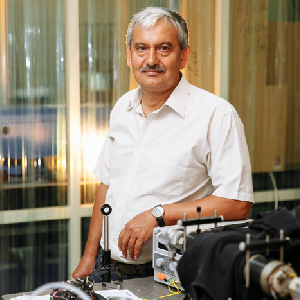An article by the international team of scholars appeared in journal Angewandte Chemie - International Edition where original works in the sphere of chemistry are published. They made a discovery the results of which can be applied for the search of new chemical entities for partitioning of heavy metals from radioactive waste of atom industry.
The research touches directly the theme of the megagrant the work over which is going at Samara University headed by Prof. Alexandre Mebel, Florida International University.
The scholars of Samara University, University of Hawaii as well as Dongguk University were the first in the world to synthesize 1,2,4,7-Cyclooctatetraene (COT), chemical group with the molecular formula С8Н7. This process is described in the scientific publication "Gas Phase Synthesis of the Elusive Cyclooctatetraenyl Radical (C8H7) via Triplet Aromatic Cyclooctatetraene (C8H8) and Non-Aromatic Cyclooctatriene (C8H8) Intermediates".
To make this research an experimental setting of crossed molecular beams situated in the laboratory of Dr. Ralf Kaiser in the University of Hawaii (Honolulu, USA) was used. And theoretical calculations of the surfaces of potential energy necessary for explanation of experiment results were executed by Alexandre Mebel at Samara University and Dr. Gab Soo Kim at Dongguk University (Seoul, South Korea). It should be mentioned that at Samara University within the megagrant currently a setting for research of combustion reactions is being built. There are only three such settings in the world – in the USA (in Berkeley and Hawaii) and in China (Hefei). For construction of the 4th setting equipment is being bought at Samara University: turbomolecular pumps, which allow providing very high vacuum (from Japan), mass spectrometer (from the USA) and the necessary laser system is already at Research and Education Centre for Physics of Nonequilibrium Open Systems and Research and Education Centre for Gas-Dynamic Studies of Samara University.
“The research the results of which we have described in the article showed that an inclusive (i.e. very profitable energetically) way to 1,2,4,7-Cyclooctatetraene goes via exotic intermediate complexes on the surface of potential energy in triplet electron state, i.e. via molecules containing two unpaired electrons (similar to an oxygen molecule)”, - Alexandre Mebel explained.
The discovery made in the course of the experiment can be demanded not only in the chemistry of combustion, but in the organometallic one as well. “In principle our method can be used for synthesis of new ligands that can selectively be coordinated to different heavy metals including actinides. Such ligands can be applied for partitioning of radioactive waste of nuclear energy stations, - Alexandre Mebel said about one of the applied significances of the research. – Some metals are more radioactive, others are less radioactive, it is important to divide them as they require different storage conditions. The search of selective ligands for partitioning of radioactive metals is the active sphere of research in the organometallic chemistry as they will help to make cheaper the existing means of radioactive waste disposal”.
For reference
Angewandte Chemie - International Edition is an international journal in which the advanced original works in the sphere of chemistry are published. The articles must include some considerably new understanding of chemistry to be suitable for a publication in Angewandte Chemie.
The journal has been indexed in Scopus since 1964, in Web of Science Core Collection since 1975. According to the data of SCImago Journal Rank the journal has Q1 quartile in all scientific spheres designated in the base: Catalysis, Chemistry (miscellaneous). In 2006 the journal impact-factor was 11.994 according to Journal Citation Reports.
 RU
RU  EN
EN  CN
CN  ES
ES 